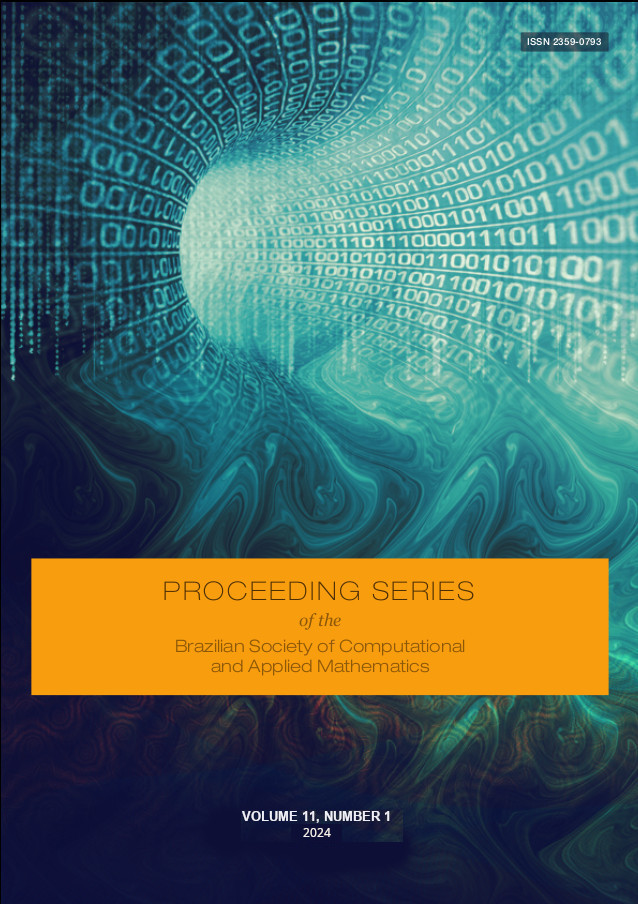A linear potential reconstruction technique based on Raviart-Thomas basis functions for cell-centered finite volume approximations to the Darcy problem
DOI:
https://doi.org/10.5540/03.2025.011.01.0332Keywords:
potential reconstruction, gradient reconstruction, error estimation, lowest-order Raviart-Thomas basis functionsAbstract
We propose a technique to recover linear potentials from the solution obtained from cell-centered finite volume approximations to the scalar elliptic problem, i.e., the cell-centered potentials and the normal fluxes on the edges. The technique employs lowest-order Raviart-Thomas basis functions to compute a local potential gradient, which is then used to obtain nodal potentials and from there a global energy-conforming potential. Numerical convergence tests in two dimensions show that the gradient of the reconstructed potential converges at O(h), outperforming reconstructions obtained via averaging of cell-centered values and producing similar results compared to a quadratic reconstruction technique.
Downloads
References
I. Aavatsmark. “An introduction to multipoint flux approximations for quadrilateral grids”. In: Computational Geosciences 6.3-4 (2002). Locally conservative numerical methods for flow in porous media, pp. 405–432. issn: 1420-0597. doi: 10.1023/A:1021291114475.
C. Bahriawati and C. Carstensen. “Three MATLAB implementations of the lowest-order Raviart-Thomas MFEM with a posteriori error control”. In: Computational Methods in Applied Mathematics 5.4 (2005), pp. 333–361. doi: 10.2478/cmam-2005-0016.
S. Cochez-Dhondt, S. Nicaise, and S. I. Repin. “A posteriori error estimates for finite volume approximations”. In: Mathematical Modelling of Natural Phenomena 4.1 (2009), pp. 106–122. issn: 0973-5348. doi: 10.1051/mmnp/20094105.
O. A. Karakashian and F. Pascal. “A Posteriori Error Estimates for a Discontinuous Galerkin Approximation of Second-Order Elliptic Problems”. In: SIAM Journal on Numerical Analysis 41.6 (2003), pp. 2374–2399. doi: 10.1137/S0036142902405217.
E. Keilegavlen, R. Berge, A. Fumagalli, M. Starnoni, I. Stefansson, J. Varela, and I. Berre. “PorePy: An open-source software for simulation of multiphysics processes in fractured porous media”. In: Computational Geosciences 25.1 (2021), pp. 243–265. doi: 10.1007/s10596-020-10002-5.
R. A. Klausen and R. Winther. “Robust convergence of multi point flux approximation on rough grids”. In: Numerische Mathematik 104 (2006), pp. 317–337. doi: 10.1007/s00211-006-0023-4.
D. Mavriplis. “Revisiting the least-squares procedure for gradient reconstruction on unstructured meshes”. In: 16th AIAA Computational Fluid Dynamics Conference. 2003, p. 3986.
J. M. Nordbotten and E. Keilegavlen. “An Introduction to Multi-point Flux (MPFA) and Stress (MPSA) Finite Volume Methods for Thermo-poroelasticity”. In: Polyhedral Methods in Geosciences. Ed. by Daniele Antonio Di Pietro, Luca Formaggia, and Roland Masson. Cham: Springer International Publishing, 2021, pp. 119–158. isbn: 978-3-030-69363-3. doi: 10.1007/978-3-030-69363-3_4.
C. J. Roy. “Review of code and solution verification procedures for computational simulation”. In: Journal of Computational Physics 205.1 (2005), pp. 131–156. doi: 10.1016/j.jcp.2004.10.036.
E. Sozer, C. Brehm, and C. C. Kiris. “Gradient calculation methods on arbitrary polyhedral unstructured meshes for cell-centered CFD solvers”. In: 52nd Aerospace Sciences Meeting. 2014, p. 1440.
M. Vohralík. “A posteriori error estimates for lowest-order mixed finite element discretizations of convection-diffusion-reaction equations”. In: SIAM Journal on Numerical Analysis 45.4 (2007), pp. 1570–1599. issn: 0036-1429. doi: 10.1137/060653184.
M. Vohralík. “Unified primal formulation-based a priori and a posteriori error analysis of mixed finite element methods”. In: Mathematics of Computation 79.272 (2010), pp. 2001–2032. issn: 0025-5718. doi: 10.1090/S0025-5718-2010-02375-0.

